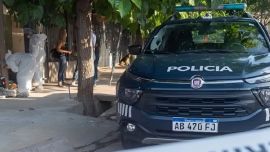It has happened in many places, the repetitious mention of events in the recent past. In this case, it’s the seventies in Argentina. Many component questions have not found answers. Recent history is here to torment us, coming back again, and again. And only a clear attempt to delve into something and explain it might just help to understand what happened in Argentina.
It has happened before, of course. More than a couple of generations took delayed sides against one another, over whom to support in political terms, be it landowner ruler Juan Manuel de Rosas (1793-1877) and his arch-rival liberal and president, Domingo Faustino Sarmiento (1811-1888). They must have turned in their graves as young Argentines brought them back to life and took sides right up to the late sixties. Since then, they have moved onto quieter debate. Then they chose guns of course, such as Peronism and anti-Peronism, over the life and corpse of general and president Juan Domingo Perón (1895-1974). Move to Radical party popular nationalists against Conservatives, etc. Now in almost weekly doses, reason is found to recall and show annoyance. There is no reason to argue the seventies, or what we mean roughly as from 1971 to 1983. And there has been no action by any government since the seventies, bar that of Raúl Alfonsín’s effort in the trials of 1985, to seek a solution as a matter of state. There is no solution to explain now.
On January 31, La Nación lashed out at what it called a partisan judicial system in a lengthy editorial criticising the use of legal distortion to avoid sentencing former leaders of the ERP-People’s Revolutionary Army for extreme cruelty in the abduction, in August, 1974, the torment and later murder of colonel Argentino del Valle Larrabure, 43, in August, 1975. Larrabure was considered a brave man who had resisted injury and deprivation in his reduced cell. The ill-treatment from his captors and the ferocity of La Nación’s editorial reflect the fact that such a case will not be put aside. That is to peer into one side of the seventies.
The view from another political side is in the second edition about a little-known guerrilla product of the late seventies (albeit perhaps common currency for the internal circuit). This was a nursery or baby boarding school in Havana which, in a solidarity drive, the Cuban government allowed to be developed for the children of combatants returning to action in Argentina and also from other countries in South America and in the Middle East. In fact, the guerrilla parents were leaving their children in the care of a safe house in Havana. The book is a new edition of, La guardería Montonera (“The Montonero Nursery, in Cuba for the children of the Counter-Offensive”), by Argentine journalist Analía Argento, which first published in 2013 by the Marea imprint.
There are two areas from which to observe the contents of the book.First, there is the sympathy you may or may not have with guerrilla causes and how they go about their business and agree on their aims and obey the orders of their chieftains. The other area encompasses how one looks at individuals involved in insurgent action – the rebels, guerrillas, subversives, terrorists, enemies of the government, killers for a cause, liberators or whatever other adjective you prefer in the language expressed against the participants in an insurrection or rebellion. The importance of the characters is their degree of commitment which, in this case, is what leads them to leave their children in a foreign ‘home’ to return to their country and to action.
In Analía Argento’s book, set in and around 1979, she goes fairly deep in her search to describe the people involved in the last stages of guerrilla action in Argentina. The book starts with a conversation in a San Telmo café between the author and a man in his 30s who was left by his parents, militant members of Montoneros, in the baby school in Havana while the adults returned to Argentina for a proposed few weeks or months to promote insurgency and disturbances that would undermine the military government. This was after the 1978 World Cup had been won by Argentina. The feeling described by the author is that the public was sick of “the terrorists.” The man in the café was just about a year-and-a-half old at the time and he never saw his mother again. She was picked up in Brazil and disappeared. The same happened with militants in Peru and in Buenos Aires.
First, serious indications here could be that the Montoneros group in Havana might have been infiltrated, that the woman who disappeared in Brazil was captured as part of combined assistance operations agreed between several South American military governments. Second, local investigators may have held considerable information on many activists who had fled into exile in 1976. Third, why did the Montoneros leadership need to launch such a flimsy counter-attack? The guerrillas had been defeated at home.Their leaders had fled abroad, had been killed, were in prison or disappeared.
Author Argento’s research takes her into the children’s lives and those of the parents who stayed on as caretakers. The Montoneros called the return a “counter-offensive” that would confuse the military dictatorship (by radio broadcasts, factory floor speeches, attacks against public figures, etc.). The leadership announced that training had already begun. The plan was outlined and agreed by the leaders of the Montonero Peronist Movement at a meeting in Rome in the second half of 1979. Attending the meeting was the guerrilla chief, Mario Eduardo Firmenich, now a university lecturer somewhere near Barcelona; the second-in-command Roberto Perdía, who eventually returned to Buenos Aires with a pardon; a commander based in México, Raúl Yäger, and Europe-based chieftains or trigger-man Rodolfo Galimberti (1947-2002) who died of a heart attack in Buenos Aires, and poet Juan Gelman (1930-2014) who returned to Buenos Aires but died in Mexico. Galimberti and Gelman promptly left the organisation advising that the group could not withstand much repression, and that Firmenich had not been in Argentina for over a year so was quite disconnected. The guerrilla system was out of touch. The adventure appeared to be a stage set in the lunatic fringe.
The returnees were wiped out. A few managed to escape back into exile. It is not clear why such an operation was planned. Apart from strategic ignorance, the timing was wrong. Networks had been destroyed. Between September 6 and 20, 1979, a team from the Committee for Human Rights of the Organisation of American States was in Buenos Aires to report on conditions in Argentine prisons and the international publicity was widespread, and might have even served the guerrillas later.
There is one final twist which sounds horrific, but was never proved or denied. The information claims that Firmenich betrayed his own troops. He negotiated with the late Admiral Emilio Massera a return which would end in captures, but not killings. Survivors released from prison could later rejoin unarmed politics. They were slaughtered.























Comments